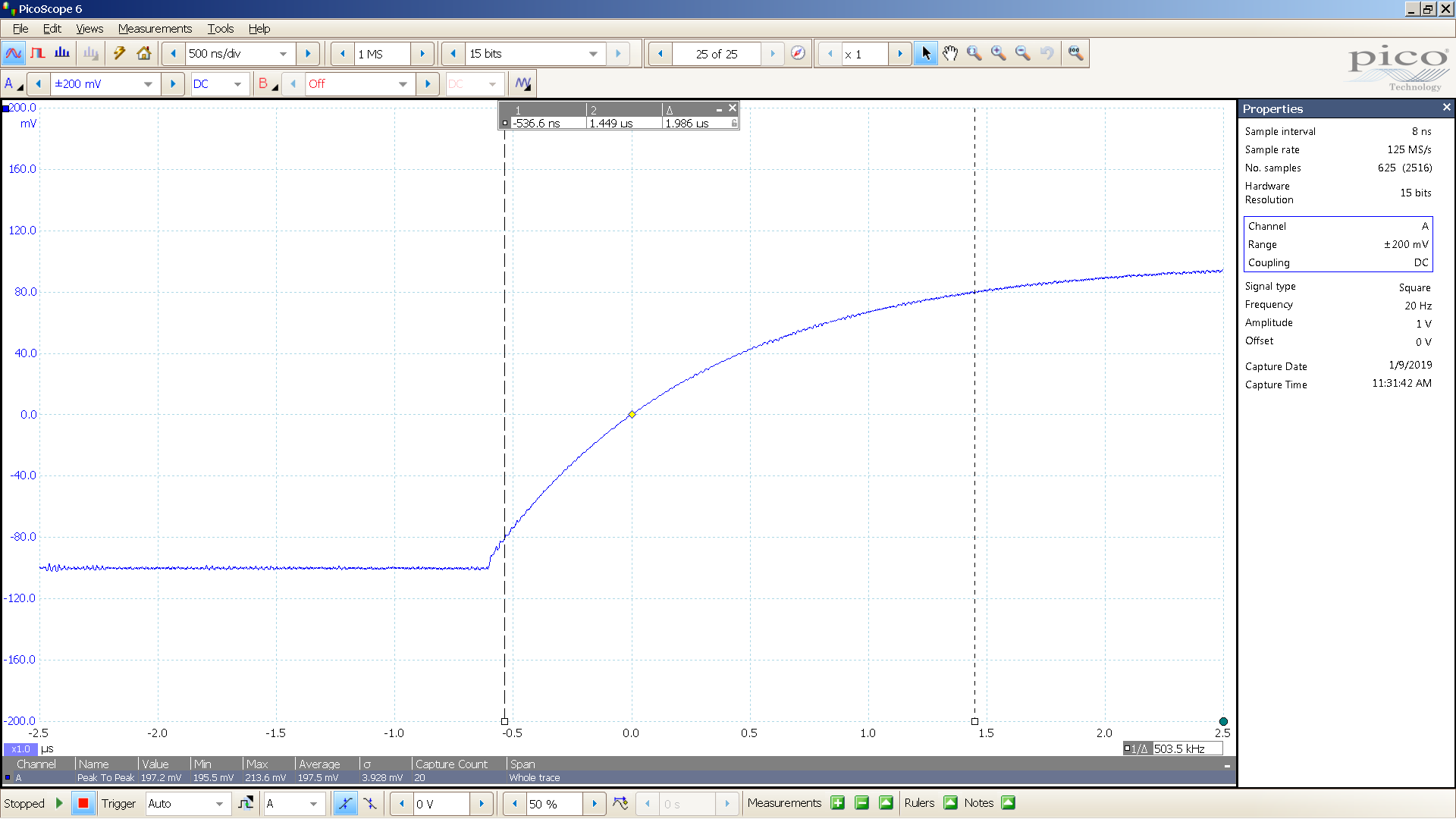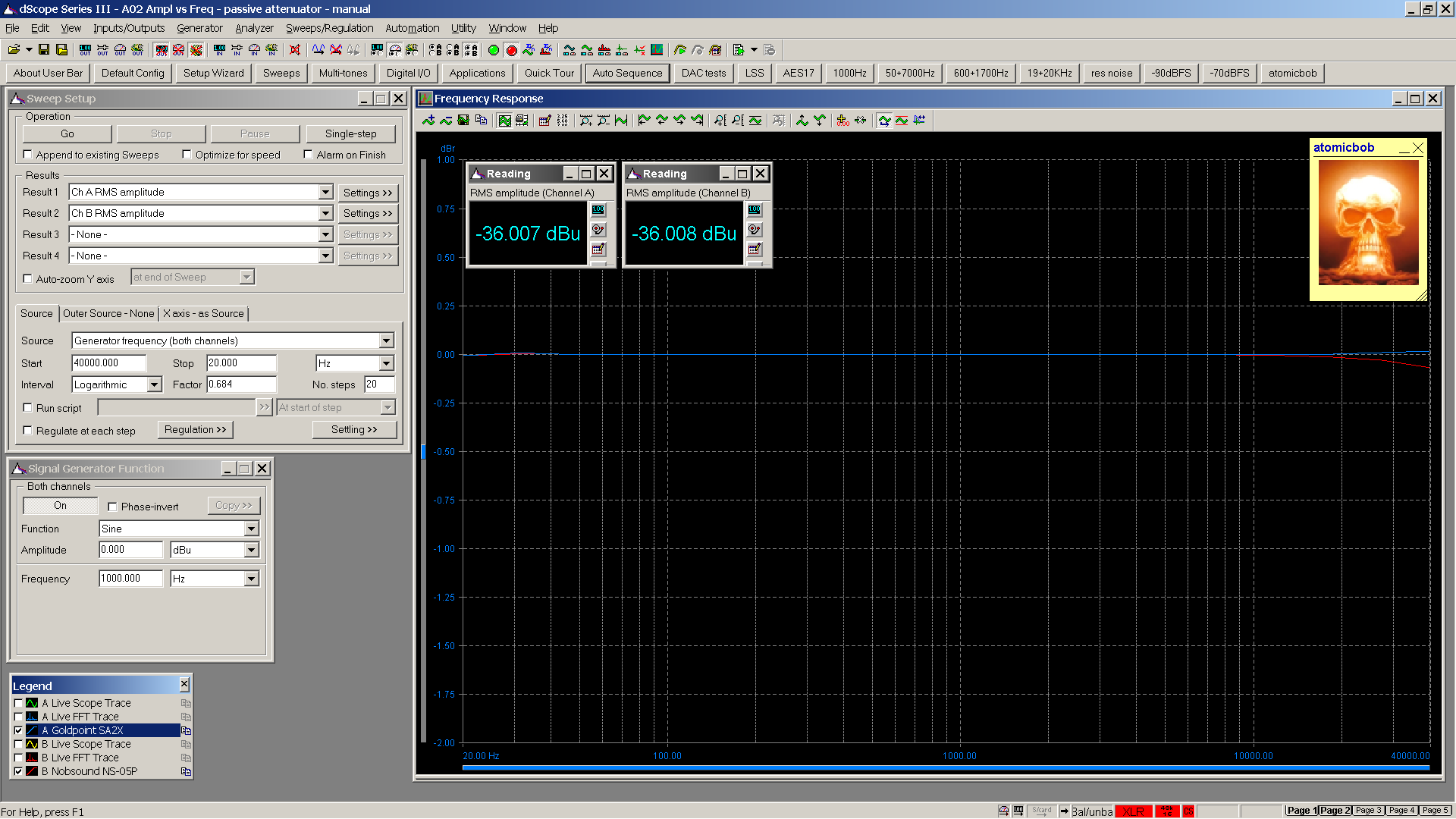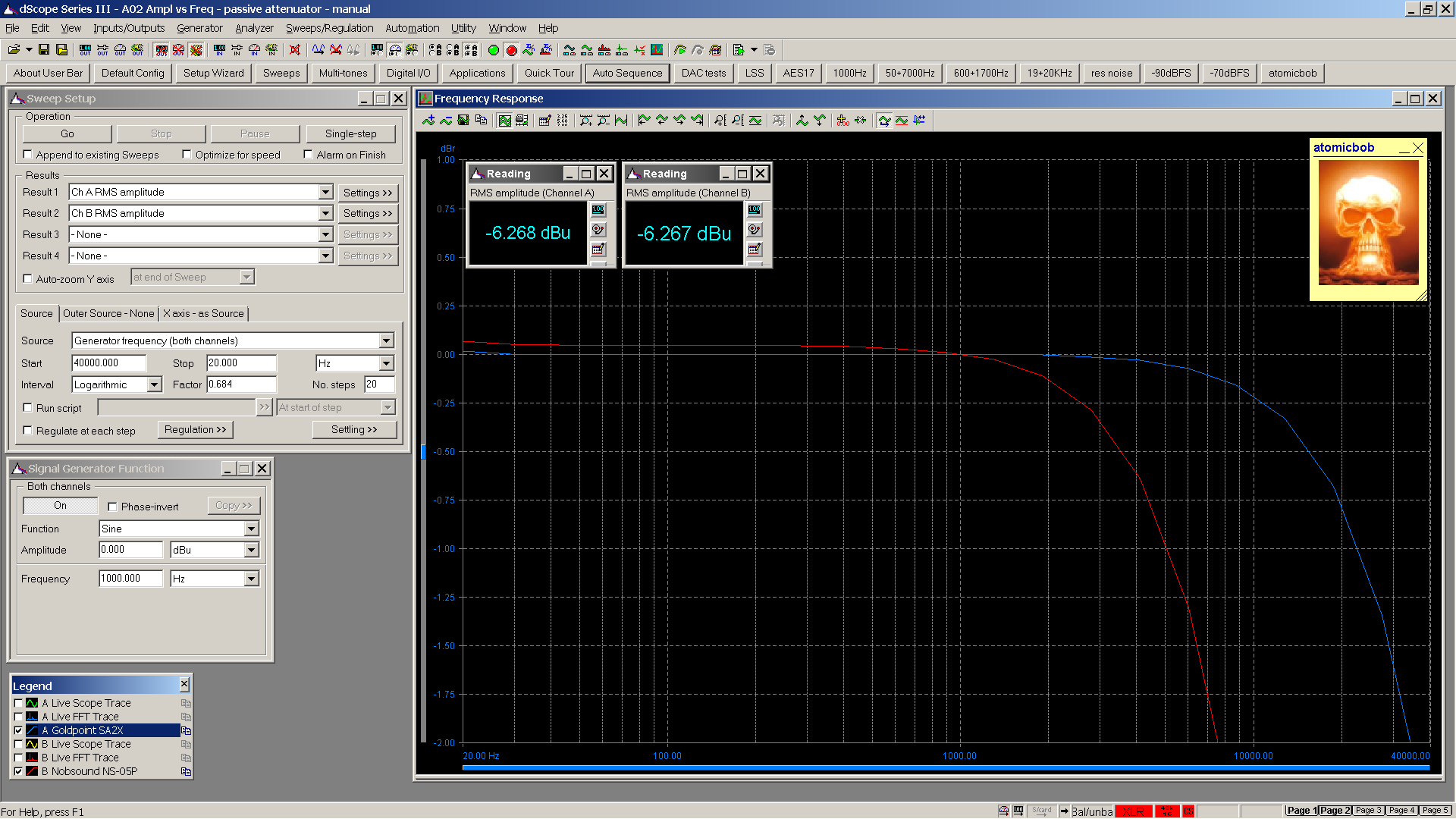atomicbob
500+ Head-Fier
- Joined
- May 27, 2012
- Posts
- 986
- Likes
- 1,040
Goldpoint SA2X - Nobsound NS-05P passive attenuator comparison technical measurements
Standard Prologue
If you are unfamiliar with audio measurements please use a search engine with the query:
"audio measurements" or "audio measurement handbook"
Look for publications by Richard C. Cabot and also by Bob Metzler, both from Audio Precision. There are other useful publications as well. These will provide basic knowledge.
Interpretation of the following measurements is usually beyond the scope of technical measurements posts. This post will be somewhat of an exception.
The data presented were collected as follows:
1. PrismSound dScope III, picoscope 5243B
2. Balanced cables Canare L-4E6S starquad and Belden 1800F with Neutrik XLR connectors
3. Single Ended cables Audioblast HQ-1 1.5 ft with Rean RCA connectors or RG6 with BNC connectors
4. 75R RCA to BNC adapters as necessary
5. Vaunix Lab Brick USB hub for measurement equipment
6. Audioquest Forest and Schiit Pyst USB cables used for measurement equipment
7. 14 and 16 AWG sheilded power cables used
All testing performed at +20 dBu input and 20 dB attenuation unless otherwise noted.
Post table of contents
1. Introduction and Background
2. Select Measurement Comparisons
3. Square Wave Response and Channel Imbalance
4. Frequency Response vs Attenuation
5. Frequency Response vs cable type and length
Introduction
The BIG QUESTION: will the NS-05P at $50 provide similar performance to an SA1X which is 10x $$$?
The BIG ANSWER: it depends.
Unsatisfying for TL;DR but unfortunately this is the correct answer. With optimal setup conditions both will perform similarly. But when the setup is more challenging, serious shortcomings of the NS-05P are revealed.
SA2X and SA1X employ the same stepped attenuator. The SA2X has two inputs and an input selector switch. I'm using the SA2X for this comparison as it was within easy reach when I began this evaluation exercise. All performance assessments apply equally to the SA1X.
Background
Most amplifiers, both speaker and headphone have the following basic block diagram:

Output level is controlled by a potentiometer attenuating input signals before sending to a fixed gain amplification block. In essence nearly all amplifiers have a passive attenuator.
When a high output signal source is applied to an amplifier designed for a much lower input signal level, the amp volume control will often need to provide large attenuation with the volume knob at the minimum extremes. Many potentiometers will change levels greatly with little movement on the knob and have increased channel imbalance issues at this extreme operation. One solution involves attenuating the hot signal source with an external passive attenuator allowing the internal potentiometer to operate in a more favorable performance range.

An external passive attenuator (or passive preamp) can provide the desired level match with minimal signal degradation, but it is important to know limitations and constraints. One extremely important consideration is the distributed capacitance of the interconnecting cable between the output of the attenuator and input of the amp. The connection forms a simple RC low pass filter. Such a filter has potential to roll off high frequencies. Such constraints will be explored while comparing measured performance of two passive attenuators.
Very important design differences between SA2X and NS-05P
SA2X 10K ohm stepped attenuator, 4 gang switch with precision low noise resistors
NS-05P 50K ohm potentiometer, ALPS 4 gang
Picture of the Audio Lab setup for SA2X and NS-05P measurements and listening

RME ADI-2 Pro reference output set to +24dBu for listening evaluation
Standard Prologue
If you are unfamiliar with audio measurements please use a search engine with the query:
"audio measurements" or "audio measurement handbook"
Look for publications by Richard C. Cabot and also by Bob Metzler, both from Audio Precision. There are other useful publications as well. These will provide basic knowledge.
Interpretation of the following measurements is usually beyond the scope of technical measurements posts. This post will be somewhat of an exception.
The data presented were collected as follows:
1. PrismSound dScope III, picoscope 5243B
2. Balanced cables Canare L-4E6S starquad and Belden 1800F with Neutrik XLR connectors
3. Single Ended cables Audioblast HQ-1 1.5 ft with Rean RCA connectors or RG6 with BNC connectors
4. 75R RCA to BNC adapters as necessary
5. Vaunix Lab Brick USB hub for measurement equipment
6. Audioquest Forest and Schiit Pyst USB cables used for measurement equipment
7. 14 and 16 AWG sheilded power cables used
All testing performed at +20 dBu input and 20 dB attenuation unless otherwise noted.
Post table of contents
1. Introduction and Background
2. Select Measurement Comparisons
3. Square Wave Response and Channel Imbalance
4. Frequency Response vs Attenuation
5. Frequency Response vs cable type and length
Introduction
The BIG QUESTION: will the NS-05P at $50 provide similar performance to an SA1X which is 10x $$$?
The BIG ANSWER: it depends.
Unsatisfying for TL;DR but unfortunately this is the correct answer. With optimal setup conditions both will perform similarly. But when the setup is more challenging, serious shortcomings of the NS-05P are revealed.
SA2X and SA1X employ the same stepped attenuator. The SA2X has two inputs and an input selector switch. I'm using the SA2X for this comparison as it was within easy reach when I began this evaluation exercise. All performance assessments apply equally to the SA1X.
Background
Most amplifiers, both speaker and headphone have the following basic block diagram:

Output level is controlled by a potentiometer attenuating input signals before sending to a fixed gain amplification block. In essence nearly all amplifiers have a passive attenuator.
When a high output signal source is applied to an amplifier designed for a much lower input signal level, the amp volume control will often need to provide large attenuation with the volume knob at the minimum extremes. Many potentiometers will change levels greatly with little movement on the knob and have increased channel imbalance issues at this extreme operation. One solution involves attenuating the hot signal source with an external passive attenuator allowing the internal potentiometer to operate in a more favorable performance range.

An external passive attenuator (or passive preamp) can provide the desired level match with minimal signal degradation, but it is important to know limitations and constraints. One extremely important consideration is the distributed capacitance of the interconnecting cable between the output of the attenuator and input of the amp. The connection forms a simple RC low pass filter. Such a filter has potential to roll off high frequencies. Such constraints will be explored while comparing measured performance of two passive attenuators.
Very important design differences between SA2X and NS-05P
SA2X 10K ohm stepped attenuator, 4 gang switch with precision low noise resistors
NS-05P 50K ohm potentiometer, ALPS 4 gang
Picture of the Audio Lab setup for SA2X and NS-05P measurements and listening

RME ADI-2 Pro reference output set to +24dBu for listening evaluation
Last edited:


































































